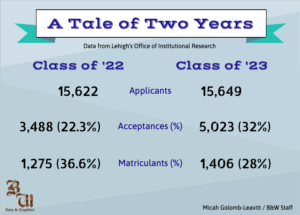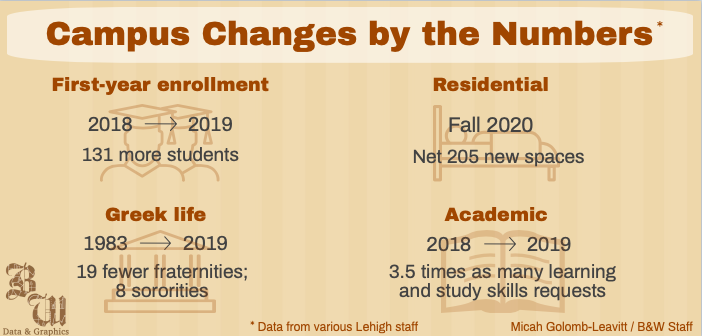Relief is on its way.
Funds were made available earlier this semester to hire a new full-time therapist to the university’s counseling center, Ian Birky said, the director of the school’s counseling services for 30 years.
Birky said he’s been requesting a full-time therapist for five years.
Whether this new therapist will be physically placed in the center’s office space in Johnson Hall, however, is another question.
Birky isn’t the only individual on campus experiencing the growing pains of an expanding university. The Brown and White spoke to over 20 individuals at Lehigh, including students, staff, faculty and members of the university’s senior leadership team, to better understand how increased student enrollment is, or is not, impacting individual jobs and the institution’s operations.
This story documents the responses and opinions of Lehigh’s Student Senate leaders, and several staff and faculty members. Read here for a second story documenting the perspectives of several members of the university’s senior leadership team.
Lehigh’s Path to Prominence officially kicked off its plan to grow the undergraduate student population by 1,000 and the graduate student population by 500 over the next 10 years, starting with the class of 2023. The university also plans to hire 100 new faculty members, in association with the College of Health, which is slated to open next fall.
“If we were just even at the equivalent rate of our comparison schools, we would’ve gotten three (new therapists)… so there’s some response, and I want to be grateful for that. There’s always this crying wish for more,” Birky said. “Resources, it’s a tough situation. I have the same budget today that I had probably about 30 years ago.”
Birky said his staff, which includes four other professional staff members and eight clinicians in training, sees 23 students per week—the maximum he can reasonably permit—no matter the population of the student body.
“We did some research a number of years ago, and we looked at a couple variables,” Birky said. “We found that students who come to Lehigh from more than 500 miles away and that students who come from more stressed economic backgrounds tend to have higher rates of psychological distress during their time at Lehigh. Significantly higher. To resolve that psychological distress, it’s more difficult when they’re farther away from their family support systems. In this Path to Prominence, those are some of the populations that we’re bringing to Lehigh.”
The head of the counseling center said that he’s had to make some adjustments as the mental needs of the university have increased regardless of growth. He said with increasing population density at Lehigh, his therapists have had to offer an approach that is “more crisis oriented than developmental growth.” While people in therapy see the most gain after six to eight sessions, Birky said, his staff has tried to meet some students’ needs in four sessions, for example, or have to refer certain individuals to private, off-campus therapists, where it is not guaranteed a students’ insurance will be accepted.
Bruce Bunnick, the director of undergraduate admissions, said his team’s goal was to grow the current first-year class by about 150 students compared to the typical freshman class, in 2019. He said he was satisfied with the final result: Lehigh enrolled 1,406 first-year students compared to the 1,275 students enrolled in 2018.
However, while enrollment increased by over 125 students in one year, the number of applicants to the university went from 15,622 to 15,649, an increase in 27 applicants. Therefore, the acceptance rate rose from 22 percent in 2018, to 32 percent in 2019.
Bunnick said the average SAT score rose in this year’s class compared to last years, and between 2018 and 2019, matriculation rates decreased from 36.6 percent to 28 percent, according to university statistics.
Bunnick said it was a busy summer for him and his staff of 16, which hasn’t increased in over 10 years.
“We always knew, and we always collected a deep enough waitlist where if there was a shortfall, that we can make up new spots through the waitlist,” Bunnick said. “This will be the new normal, utilizing the waitlist in May and into June. With the growth, we knew we were going to utilize the waitlist. Traditional recruitment methods with the growth were going to have to be changed… we had a plan, and we began to deploy it.”
 Bunnick said the nature of his job has changed to “a faster pace” that now requires communicating with students as early as the 10th grade, which is “not something we have always practiced at Lehigh.”
Bunnick said the nature of his job has changed to “a faster pace” that now requires communicating with students as early as the 10th grade, which is “not something we have always practiced at Lehigh.”
Still, Bunnick supports the university’s plans to grow and said the expansion is overdue.
“I’m actually excited about the challenge for this university to propel itself to a position of greater visibility among the best institutions in the United States,” Bunnick said. “I’m the kind of person who loves a challenge and looks forward to it. I feel like this is an exciting time to be in this endeavor, in this profession. I am very, very supportive of this growth.”
Bunnick said he is considering an increase to his staff, but is also thinking of ways in which his office can “work smarter.” He said each staff member is expected to read 35 applications per day during the time period of Regular Decision applicants, and said he has hired adjunct or part-time help when necessary.
Considerations of increases in staff size to meet the student need has hit Lehigh’s police department, too.
“(Staff size is) something that we’ve been discussing since I even started here: how are we going to adapt to what will no doubt be an increase in calls for service from us… It’s certainly one of the options that I’m seriously considering and will most likely be asking for…” said LUPD Chief Jason Schiffer. “The answer isn’t always just add more people—it’s maybe using the resources that you have more effectively, more efficiently, but there definitely could come a time, and there may come a time, when more manpower is definitely needed because of the increased population.”
With the first of 10 years of intentional student growth in the books, some offices, departments and faculty members have been feeling the ripple effects.
Kara Uhrich, the director of the Center for Academic Success, said her office has received 3.5 times as many learning and study skills requests in September 2019 as she did in September 2018. She noted the amount of students her office sees depends on the time of the semester, with increases coming around exam time and generally growing over the course of the semester.
The Center for Academic Success consists of one director, one coordinator, three graduate assistants, eight office assistants and approximately 100 peer tutors.
“The demand for tutoring has increased each year over the past five years,” Uhrich said in an email. “We have hired additional tutors and employed tutors for more hours in order to accommodate the rising increase in tutoring demand.”
For Stefanie Burke, the assistant dean and director of first-year experience, increased student growth may come with logistical considerations.
For the first time since she took this position five years ago, some orientation programming for first-year students had to be held at Goodman Campus. The annual convocation for the first-year class was held at Stabler Arena, instead of at Grace Hall, where the event had been held previously.
She said her office’s budget is essentially funded by the orientation fee charged to first year students. While more students could mean more revenue, she noted that expenses will increase, too.
“There’s definitely the change you can’t anticipate, but it’s not necessarily out of the normal. We’re constantly reviewing our programs and services – we do that every year, so that’s not abnormal,” Burke said. “With the changing student population, we’re doing that to a greater extent and we’re trying to anticipate needs and be proactive…. Which still is not abnormal, there’s a different group every year, but it’s heightened with more students and with Path to Prominence. We’re looking at a more diverse group of students and that’s something we’re really conscious of.”
David Joseph, the executive director of Student Auxiliary Services of 36 years, is working with Ozzie Breiner, the director of Housing Services, to oversee several key changes across housing and dining as the university grows.
Joseph said in housing, the university will add a net of 205 spaces next fall. By the start of the next academic year, Trembley Park will be demolished, which holds 200 students currently, and Phase I of the New Residential House, which will hold 405 students, will open. Phase I will cost about $75 million, Breiner said.
He also touched on the impact of the new cafe at E.W. Fairchild-Martindale Library, which is now servicing 1,000 students every day. Joseph noted that when 405 students move in across from the University Center, he expects those dining facilities to pick up, too.
Joseph said there are eight staff members in Housing Services and 250 to 300 employees in Dining Services, though all dining employees are employed through Sodexo, not directly by the university.
“More residence halls are more students, more bills, more potential complaints – the more people we house, the more issues that come up and hopefully the more satisfaction on the other side as well,” Breiner said. “Those are the kind of things we deal with on a daily basis. Budget wise, we have a need for more funding.”
Breiner said “housing is a business,” and the office determines how much it will need to charge in order to meet its expenses for items such as insurance, residence life programming, maintenance and cable TV.
One big change in terms of housing Breiner has noticed is the shift away from Greek life.
“In 1983, there were 32 (fraternities), but you can see what it’s changed to over time – eight sororities and 13 residential fraternities,” he said. “So now we use those as special interest housing or regular housing for second, third or fourth year students.”
The trend away from Greek life at Lehigh is something Julia Pardee, ‘21, the president of the Student Senate, has noticed, too. She said it’s all the more reason for changes to Student Senate’s budget.
“More students are taking part in clubs…. It’s really exciting to see that growth and we want to support that and so we need more funding,” Pardee said.
Pardee said Student Senate has made moves to better recognize the growing student body. Total student senators has increased from 55 to 60, and each constituency now receives 10 senators instead of nine.
Student Senate received the increase in funds Pardee said was needed to “best service the student organizations on campus,” with help from the Dean of Students. Pardee has proposed that moving forward, a set amount of the student activity fee, included in each student’s tuition expenses, goes directly to the allocations fund in order to organically increase Student Senate’s budget as student enrollment ticks up.
Eugene Rohrer, ’22G, the president of the Graduate Student Senate, questioned the role graduate students play in the university’s Path to Prominence.
“The university has made clear its general plan to improve infrastructure, expand the student population and promote the research prestige of Lehigh. Beyond that, it’s unclear what role graduate students will play in the Path to Prominence,” Rohrer said in an email. “…It is unclear what the Path to Prominence actually entails for grads other than increased enrolment.”
Rohrer said GSS generally supports graduate student clubs, travel grants and a general activities fund. However, Rohrer said GSS has been unable to increase the sizes of its travel grants in over 10 years “despite our continued request for budget increases.” Currently, travel grants are able to offer $75 for a student presenting at a conference and $150 for presenting research, Rohrer said.
“As enrollment increases, it is imperative that we have additional funding to account for the larger population that we are trying to serve,” Rohrer said.
Conversations around growth are ongoing amongst faculty members as well. Dawn Keetley, a professor and the chair of the English department, and Bruce Whitehouse, an associate professor of sociology and anthropology, both expressed support for growth but want to hear more about the need to expand the university.
Keetley said she has received the funds needed to hire adjunct professors to teach first year writing, but is “still waiting for the growth in permanent tenure faculty.”
“My general feelings are that (growth is) good. I want Lehigh to be as vibrant as possible, so I’m completely happy with the idea of growth with the caveats that growth in students needs to be fully planned for and supported, otherwise growth can be a problem…” Keetley said. “If it’s just about getting the money, the tuition dollars that extra students bring in, I’m kind of opposed to it.”
Keetley added that her department, which includes 21 full-time faculty members, lost one of its three coordinators in recent months and does not have plans for replacement, but that she believes the department can function adequately with two coordinators.
Whitehouse said his first-year seminar of 19 students is “a little different from the typical Lehigh undergraduate sample,” which he described as largely upper middle class, white, suburban and from the tristate area. He said he thinks it’s “great” that he’s seen students who don’t fit that mold, since he believes that population is shrinking and Lehigh needs to therefore broaden its recruiting pool.
Still, he said he wants to hear a clearer articulation of why prospective students should choose Lehigh, and noted Path to Prominence isn’t without its challenges.
“For now (staff can manage the quantity of students). This is the greatest source of uncertainty – will we be able to replace a colleague, am I going to have to start teaching more students or more classes, will we restrict the range of course offerings because somebody left and we haven’t replaced them?” Whitehouse said. “We don’t know, and that’s a source of anxiety.”
Doug Mahony, an associate professor of management and chair of the Faculty Senate, and Kathy Iovine, a professor in biological sciences and vice chair of the Faculty Senate, agreed sustainable growth for the university is positive. But they have concerns, especially around science classes and labs.
“For us in biology, we’ve had increasing numbers in undergraduates beyond the increasing enrollments at Lehigh – more students in our classes, entry level classes increasing in numbers. The pressure is at the lab, because we have limited lab space, and you can’t just overfill a lab for safety reasons,” Iovine said. “There’s been a squeeze on us having the support we need for the labs.”
Another part of Lehigh’s expansion includes the creation of new positions to give the university greater visibility in various fields – like this past summer’s hiring of David Rubenstein as the inaugural executive director of the health and wellness center. Rubenstein was hired about two months after Thomas Novak, the interim health center director, was placed on leave in May.
Rubenstein said one of his first priorities will be “shoring up staffing,” which currently consists of three nurses, two physicians, two nurse practitioners, two front office staff members and one coordinator. He said he is committed to ensuring that the health and wellness center provides services that meet the student need and matches the student enrollment.
Rubenstein is tasked with developing a health and wellness plan for the university, including a corresponding budget, to integrate student services, access and staffing in order to create a “wellbeing-informed campus.”
“Providing health and wellness is just so important for the entire campus. Academic, emotional, social success is predicated on wellbeing, student wellbeing,” he said. “The university is right to be putting health and wellness at the forefront of the university.”
This report was compiled by The Brown and White’s Investigative Team.






Comment policy
Comments posted to The Brown and White website are reviewed by a moderator before being approved. Incendiary speech or harassing language, including comments targeted at individuals, may be deemed unacceptable and not published. Spam and other soliciting will also be declined.
The Brown and White also reserves the right to not publish entirely anonymous comments.
2 Comments
I believe in 1984 there were six sororities: KAT, APhi, uh…clearly this wasn’t a big part of my life, because I don’t remember the rest. But I’m pretty sure there were six, because people kept insisting I had to rush and so I went and schlepped around to the parties. Alpha Omicron something? I don’t know. Anyway, there are more sororities now, many fewer fraternities, maybe because on the whole the girls behaved less wretchedly than the boys.
I do know the girls weren’t dainty princesses, because I remember my horror at discovering, when I moved into my grad school apartment, that I’d accidentally rented a place across the street from two or three sororities. I looked into moving but it was just too late. As it turned out, this school’s sorority girls were dainty princesses, and the most raucous they got was standing out in the street late afternoon early in fall, all dressed up in evening gowns, and singing a pretty song with a lot of clapping to welcome the new rush freshmen. Or someone. Then they went inside and I never heard them make noise again. It was astonishing and bewildering, and a great relief.
Maybe Lehigh should focus less on growing the student body and more on the students it currently has. I’m saddened to learn that only $150 is available for conference travel grants. My grad school covered my travel, accommodation, and food expenses in full (~$2,000). Had they not, I would never have been able to attend the conference.
An institution that does not support research and scholarship is not on a path to prominence.